Triton Explains: Wave Energy
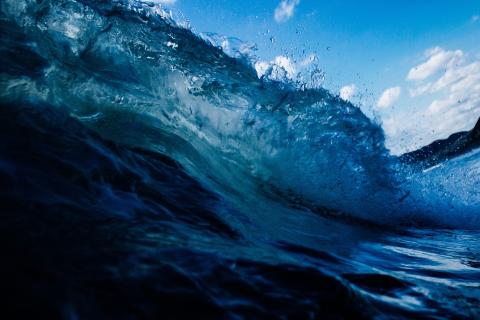
As the demand for carbon-neutral electricity rises, it is necessary to identify, vet, and secure sustainable resources beyond what currently composes the nation’s energy portfolio. With water covering two-thirds of the Earth’s surface, the ocean represents a vast, untapped resource that could provide energy security for generations to come. The Department of Energy Water Power Technologies Office (WPTO) recognizes that harnessing waves, tides, and ocean currents presents an immense potential for energy production. In an effort to transition from fossil fuels to renewable sources, there is a need to understand the most effective ways to responsibly capitalize on the power of the ocean to power human activities. Based on a 2021 report entitled “Marine Energy in the United States: An Overview of Opportunities,” wave energy has the potential to significantly contribute to the energy needs of the United States. Together, with the recent push to increase offshore wind development in the United States, continuing to explore and advance wave energy technologies will create sustainable and lasting ocean-based solutions for generations to come.
The history of wave energy
Attempts to use waves as an energy source date back to the late 18th century. In 1799, a French inventor by the name of Pierre-Simon Girard, along with his son, designed a machine to mechanically capture the energy of ocean waves. This was the first technology of its kind and was designed primarily to power heavy machinery, including mills and pumps. Girard is recognized as the first holder of a wave power patent.
In the 1860s, the city of San Francisco, California began experimentation using wave action to power boats. Later in the century, wave energy converters and motors were being developed all over the world as people searched for new innovations to solve local environmental problems and power small communities. In California, an extreme drought in Santa Cruz during the winter of 1898 led to dust flying on the wagon roads, greatly affecting travel. The city struggled to propose a cost-effective way to sprinkle the passageways with water to settle the dust, inspiring the Armstrong brothers to build a simple wave motor inside the coastal cliff area to power irrigation.
In the 1940s, Yoshio Masuda, a chief scientist at the Japan Marine Science and Technology Centre, former Japanese naval commander, and widely regarded as the father of modern wave power technology, is credited for the creation of the oscillating water column. Masuda originally selected a floating-type device because of its simplicity, according to a report he wrote that would later detail his findings. A few decades later, in 1974, Stephen Salter, a professor at the University of Edinburgh, explored the seas around Scotland and launched the world’s first major wave energy project. Although the ocean waves proved too much for his house-sized floating generators, in recent years we have seen more devices withstanding the harsh environments that they are designed for.
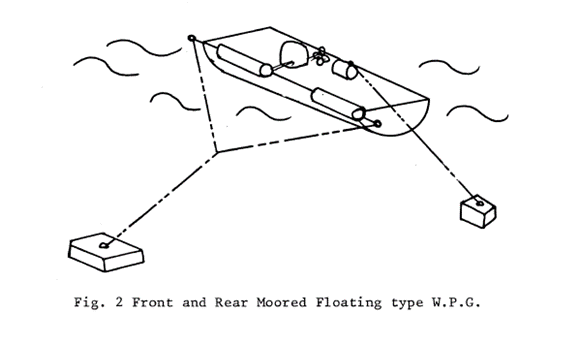
How does wave energy work?
As long-distance ocean currents approach shallow coastal regions and wind blows over the surface of open water, waves form. Devices called wave energy converters (WECs) capture the kinetic energy of ocean waves and convert it into electricity. There are various types of WECs, but they all work based on the common principle of converting the natural movement of ocean surfaces into usable and transferable forms of electricity.
A common type of WEC is a point absorber, often consisting of a floating buoy that moves in concert with the up and down motion of passing waves, capturing and converting mechanical energy from the rise and fall of surface waves into electricity through a power generator. Surface attenuators, another type of WEC, are floating devices that often have many connected segments positioned parallel to incoming waves. As the attenuator rides with the swell, internal generators capture the movement of the joints between segments and convert the energy to electricity. Alternatively, overtopping devices are typically located offshore in areas with huge swells. These devices capture water as waves break into a large reservoir, funneling the water into a chamber with a turbine that generates electricity before returning it to the sea. There are also other types of WECs such as wave surge converters and oscillating water columns, among others (learn more about the types of WECs here). Each type has a unique design and working principle, but they all aim to capture the kinetic energy of ocean waves and convert it into usable electricity at a variety of scales (e.g., to power the grid or smaller-scale Powering the Blue Economy applications).
Humans have reached a pivotal time in the search for alternative energy, where technological advancements around the world are propelling innovative solutions to harness kinetic energy from many natural phenomena. The role of the ocean in creating a future fuel through renewable energy is recognized. Creative, inventive approaches to harnessing the ocean’s power continue to be explored and tested for various applications on local and global scales.
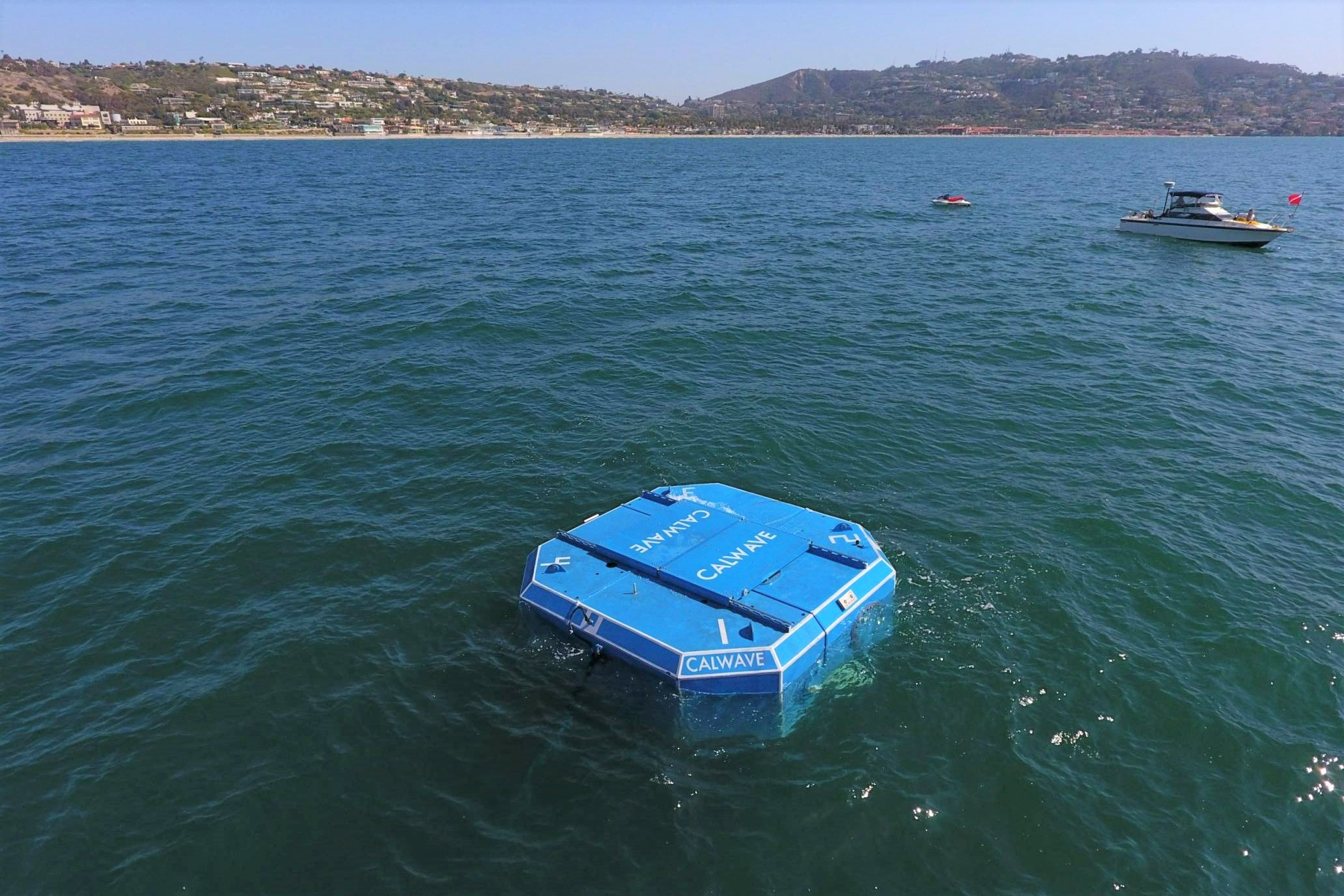 | 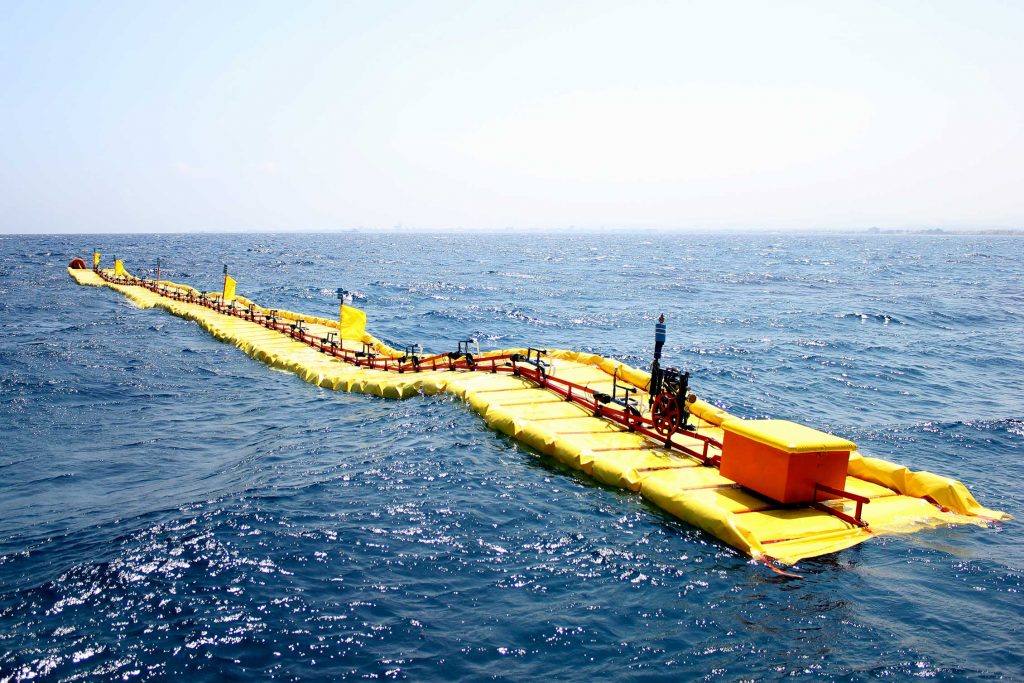 |
Benefits and challenges of wave energy
Like most marine energy resources, the benefits of wave energy conversion are abundant. Wave energy is not only renewable and carbon neutral, but it is also fairly consistent. Ocean waves are created by predictable forces, such as wind and tides, which means that wave energy can be accurately forecasted and sited to capitalize on these powerful, naturally occurring phenomena. Additionally, wave resources provide a high energy density, meaning WECs can generate large amounts of electricity within relatively small spatial footprints and without much disruption to existing infrastructure. Access to commercially available wave energy devices would allow remote and coastal communities to reduce dependence on fossil fuels and instead be powered by carbon-emission-free, consistent, locally derived, renewable electricity. Moreover, the Blue Economy stands to benefit, producing jobs for a variety of industries such as manufacturers, technicians, engineers, researchers, and more. But with strengths and opportunity come challenges including expense, scalability, and maintenance.
Despite its promising potential as a renewable resource, wave energy is still in the early stages of development compared to other alternative energy sources like wind and solar. There are only a few commercial-scale wave energy projects around the world, and most of them are still in the testing phase. One of the biggest hurdles facing wave energy technology is to ensure these devices are equipped to withstand harsh marine environments and conditions. Ocean waves are predictable and powerful—the very characteristics that make wave energy so bountiful and compelling for energy capture make device development particularly challenging. Additionally, small-scale device research and development comes with its own set of challenges. Getting devices deployed to grid scale requires investment into local, regional, and possibly larger-scale infrastructure. But wave energy technologies continue to evolve and advances in technology are propelling its growth and potential for commercialization forward.
With the development of any new technology comes concerns about environmental effects associated with deployment and operation. WECs have the potential to pose a risk to marine life through changes in habitat, potential for injurious interactions, or displacement of animals that frequent deployment areas. Additionally, underwater noise associated with the installation and operation of WECs could be disruptive to communication and life functions of marine mammals, fish, and other sensitive marine fauna. Other concerns may include the emissions of electromagnetic fields associated with transporting electricity through underwater cables. In an effort to reduce barriers to permitting and deploying WECs and other marine energy devices, the Pacific Northwest National Laboratory’s Triton Initiative, funded by WPTO, researches and develops environmental monitoring technologies as well as methods to understand these potential impacts.
Triton’s role in realizing wave energy
Researchers at Triton work with industry partners to test and develop technologies and models that can be used to investigate possible environmental concerns associated with WEC development, including underwater noise, electromagnetic fields, collision risk, and habitat change. As part of the Triton Field Trials, in 2022 the team released the first set of environmental monitoring recommendations for the marine energy industry in a special issue of the Journal of Marine Science and Engineering. The recommendations and data published in this special issue provide the marine energy industry practical tools that can help aid in the permitting process and help get WECs into U.S. waters.
Triton’s researchers also study potential impacts that can proactively be addressed by device developers. For example, Triton addressed issues associated with anthropogenic light as a potential stressor from marine energy devices, including WECs. The team conducted a review of ecological impacts of marine lighting and offered proactive recommendations that can be taken to reduce the potential harmful effects of new light sources following the installation of large arrays of devices.
Triton’s current efforts aim to better understand how receptors, such as marine mammals, fish, or habitats, interact with potential stressors associated with marine energy device deployment. These projects range from exploring aerial technologies for detecting and tracking marine animals at wave energy test sites, to understanding the particle motion component of underwater noise for assessing the possible impacts on fish and invertebrates. These studies help build knowledge around marine animal behavior in the presence of dynamic and novel marine energy technologies, like WECs.
Triton’s mission, to reduce barriers for marine energy device testing, is focused on providing regulators and developers with recommendations as well as evidence-based data to help expedite their ability to get WECs and other marine energy devices powering our communities responsibly and sustainably.
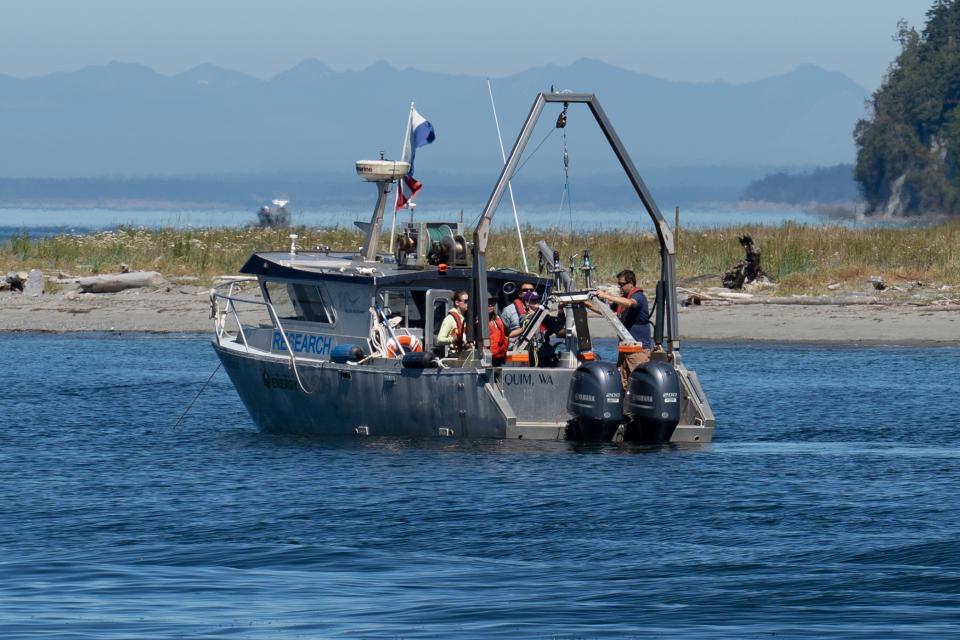
The Triton team conducting tests on underwater noise monitoring technologies in Sequim Bay, Washington. (Photo by Shanon Dell | Pacific Northwest National Laboratory).
Follow along and learn about how Triton is helping make marine energy a reality here.

Written by Rachael Gallodoro.